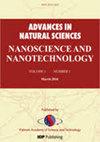基于便捷水热法制备的多孔 Pd-ZnO 纳米棒的卓越二氧化氮传感器
IF 2.1
Q3 MATERIALS SCIENCE, MULTIDISCIPLINARY
Advances in Natural Sciences: Nanoscience and Nanotechnology
Pub Date : 2024-08-16
DOI:10.1088/2043-6262/ad6b7a
引用次数: 0
摘要
在半导体金属氧化物表面装饰贵金属纳米粒子(NPs)以提高传感材料的气敏性能,引起了全球众多研究人员的浓厚兴趣。在此,我们介绍了一种在多孔 ZnO 纳米棒表面装饰 Pd NPs 以提高 NO2 气体传感性能的有效方法。多孔 ZnO 纳米棒采用简单的水热法合成,不含表面活性剂。通过使用 Pluronic 作为还原剂原位还原 PdCl2,在多孔 ZnO 纳米棒表面装饰了 Pd NPs。在 25 ℃-250 ℃ 的不同工作温度下,评估了多孔钯氧化锌纳米棒对 0.1-2 ppm 浓度范围内有毒气体二氧化氮的气体传感性能。装饰在多孔 ZnO 纳米棒表面的 Pd NPs 不仅提高了传感器的响应速度(3 倍)和再现性,还降低了最佳工作温度。气体传感活性的提高归因于通过氧吸附调节耗尽层,以及通过化学和电子机制在钯和氧化锌之间形成肖特基势垒。本文章由计算机程序翻译,如有差异,请以英文原文为准。
Excellent NO2 sensor based on porous Pd-ZnO nanorods prepared by a facile hydrothermal method
Noble metal nanoparticles (NPs) decorated on the surface of semiconducting metal oxides to enhance the gas-sensitive properties of sensing materials have attracted considerable interest from numerous researchers worldwide. Here, we introduce an effective method to decorate Pd NPs on the surface of porous ZnO nanorods to improve NO2 gas-sensing performance. Porous ZnO nanorods were synthesized using a simple hydrothermal method without surfactant. Surface decoration of porous ZnO nanorods with Pd NPs was performed through in situ reduction of PdCl2 using Pluronic as the reducing agent. The gas-sensing properties of porous Pd-ZnO nanorods were evaluated toward NO2 toxic gas in a concentration range of 0.1–2 ppm at various operating temperatures of 25 °C–250 °C. Pd NPs decorated on the surface of porous ZnO nanorods not only improve the sensor response (3-folds) and reproducibility but also reduce the optimal operating temperature. The improvement in gas-sensing activity is attributed to the modulation of the depletion layer via oxygen adsorption and the formation of the Schottky potential barrier between Pd and ZnO through chemical and electronic mechanisms.
求助全文
通过发布文献求助,成功后即可免费获取论文全文。
去求助
来源期刊

Advances in Natural Sciences: Nanoscience and Nanotechnology
NANOSCIENCE & NANOTECHNOLOGYMATERIALS SCIE-MATERIALS SCIENCE, MULTIDISCIPLINARY
自引率
4.80%
发文量
0
 求助内容:
求助内容: 应助结果提醒方式:
应助结果提醒方式:


